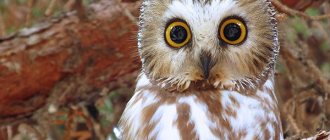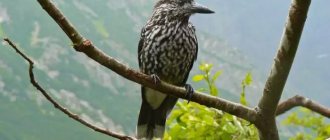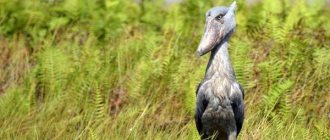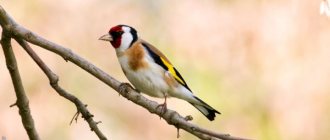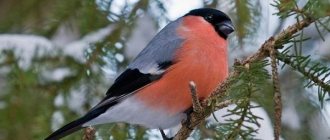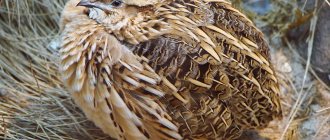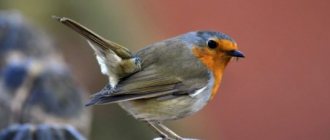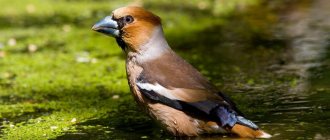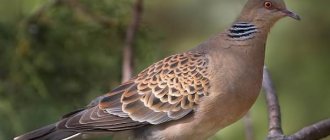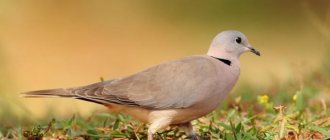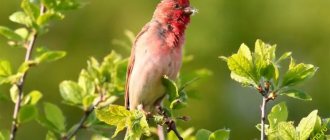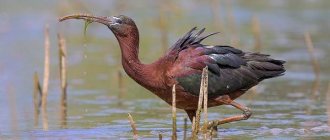Crossbill : about nature for children . What bird breeds chicks in winter? What is so amazing about this bird? Riddles, poems, stories, fairy tales, presentation about crossbill and other forest inhabitants for children. Educational fairy tale in pictures “The Crossbill and the Woodpecker.”
Today is a new page of our children's encyclopedia about wintering birds on the “Native Path” website. She will introduce us to an amazing bird - the crossbill.
A story for children about crossbill in pictures
The crossbill is always easy to recognize by its beak. Crossbills have a beak that looks like a cross. Try drawing a cross with a pencil. Now make a cross from two sticks. Does it look like a crossbill's beak? Have you seen such a cross-beak on other birds - sparrows, geese, ducks, chickens, pigeons? No? That's right, you haven't seen it and you won't see it!!! Only crossbills have such a beak! They need it to get food for themselves - to get seeds from cones. You can't get seeds from a cone with a regular straight beak! Therefore, if you see a bird with a cross-beak in a forest or park in winter, then you know that it is a crossbill. You will never confuse him with other birds!
But the crossbill is famous not only for its cross-shaped beak!
Crossbill is the most amazing bird! And the most seasoned! Not afraid of any frost! And it hatches chicks in the bitter winter during blizzards, blizzards and severe frosts. And that’s why crossbills make a very warm and durable nest. And their nest is always located very high on a pine or spruce tree, so that no one can reach the chicks.
Crossbills build their winter home for their chicks - their nest from dry spruce twigs, moss and lichens, and soft roots. And to make it warmer, they line the inside with wool and feathers. This nest must have thick walls so that the babies do not freeze in it. The nest is built by the female, the mother of the future chicks. And the male, the papa crossbill, helps her. Crossbills make a warm, durable home! Neither frost nor blizzard are scary in such a house!
The frost outside is such that people don’t even go for walks in the parks, they hurry home as quickly as possible. And at this time the mother bird sits on the nest and does not fly away from it. In her nest she has 3-4 small eggs, from which her little children - crossbills - will soon hatch. The mother of the future mites sits on snow-covered branches for two weeks. She can't fly away - she has to hatch the chicks!
How does the mother eat at this time if she cannot fly away from the nest? Who feeds her at this time? (give the baby time to think and try to find the answer to the question) Of course, dad helps mom at this time - the crossbill, who brings her food and takes care of her.
When the crossbills are born, the mother also does not leave them for a minute - she sits on the crossbills and warms them with her body.
Why do crossbills hatch chicks in winter? Because ticks need special food! Which? Of course, there is special food - children's food - that which is given to children so that they grow well. What kind of food is this very healthy? (Let the baby try to name useful products that he knows, and try to guess which of them may be needed by small crossbill chicks):
“What do you eat in the morning? Porridge. What kind of porridge? (Buckwheat, oatmeal, millet, semolina - remember with your baby). And crossbills also need porridge, but a different one - bird porridge - spruce porridge!!! And there is a lot of such porridge only in winter, because it comes from... cones! Do you know this kind of porridge? No? Listen to what kind of porridge this is and how little crossbills grow.”
N. Sladkov. Spruce porridge
Everyone's birthday is a joy. And the ticks are in trouble. What a joy it is to hatch in winter? It's frosty, and you're naked. One back of the head is covered with down.
All birds have parents like parents; they hatch their children in the summer when it is warm and nourishing. Laws are not written for crossbills alone. I managed to hatch a tick in the winter, and on the twenty-ninth of February! What kind of birthday is this that only comes once every four years? Just cry: no greenery, no caterpillars; snow, cold... And at least the parents! There's the crossbill daddy sitting on his Christmas tree and singing songs. And there’s steam coming out of his beak, as if he’s smoking a pipe! This is what I think about biting. I just see that the ticks themselves live and do not grieve! Crossbills eat porridge. Porridge made from spruce seeds is good! They'll eat enough porridge and go to sleep. From below the nest is like a feather bed, from above the mother is like a feather blanket. And the porridge warms you from the inside. The Christmas tree is cradled, the wind purrs songs for them. A few days have passed - the crossbills have grown. Neither our necks got cold, nor our noses froze. Yes, they are so thick that the nest is cramped. And restless: they almost fall out of the nest. < This is probably all from mother’s worries and from the spruce porridge. <And also from the bright sun and frosty wind. No, a birthday is always a happy day. Even if it’s winter and frost. Even if it’s the twenty-ninth of February. Doesn't matter!
You probably thought that since crossbills are born in such severe frost, they are dressed in a very warm coat, like bunnies or squirrels in winter? But no! Their down is the same as that of the chicks of other birds that hatch in the spring. And only their mother warms them! Without their mother, the crossbills will be lost! Mom warms the nest so much with her little body that it’s warmer than it is at home! Wow! You don't even need batteries or a stove!
Then the crossbills grow up, and the mother begins to fly out of the nest for a short time. How cold it is then for the kids! They hide their heads under their tummy to keep warm. And when mom returns, they quickly warm up under her. The father crossbill feeds the mother and children. He brings spruce seeds and gives them to his mother. And the mother feeds them to her babies - they bite.
Parents have to feed their babies for a long time, because they are still small and do not know how to get food from pine cones themselves. After all, adult crossbills have a cross-shaped beak, while chicks have a straight beak. You can’t get a single seed out of a cone with a straight beak! But as the kids grow up, they begin to learn how to extract seeds from cones, their beak will also bend and become like a cross. Then they will begin to get food for themselves, using their cross-shaped beak to push apart the scales of the cone and take out the seeds.
Crossbills are very friendly birds. They love to fly in flocks and always build nests where there are a lot of cones with seeds. But as soon as the couple wants to hatch chicks, it flies away from the flock, makes a nest and lives in it. And as the crossbills grow up, the family with the crossbills returns to the common flock. It is easier to feed and survive in the forest in a flock.
Crossbills have another name. They are called very funny - “northern parrots”. Can you guess why? How are they similar to parrots? Yes, they are bright like parrots, they also have wings, legs, a head, a tail, they also know how to fly. And crossbills, like parrots, can climb branches and even hang upside down! Take a look at the picture. They are like real dexterous gymnasts! They hang upside down on a branch and eat the seeds!
Crossbills never completely peck out the seeds from the cones. A few seeds will be pecked off, and the rest will be left in the cone. And after eating the cone is dropped on the ground. And therefore we can say that crossbills are very useful birds for the forest. They are like foresters planting forests. How can they plant a forest if they don’t even have hands - only wings? (Give your child the opportunity to think about the answer to this question, prompt him with questions: “What does a spruce or pine grow from? From a cone! Where should a cone be so that the seeds from it fall into the ground and then become small fir trees or pine trees? How can crossbill help the tree and its children - seeds?" Tell us that from the cones thrown by crossbills on the ground, small trees then grow. Therefore, we can say about crossbills that they plant a forest)
Reproduction
The crossbill is a frost-resistant bird. Like other birds, they breed when there is enough food. Chicks are born in both autumn and spring, but most often at Christmas. Nests are built on the tops of coniferous trees or under the reliable claws of branches to protect the home from moisture. Usually they choose those places that are rich in food, because in this case they will not have to leave the offspring unattended for a long time.
The walls of the nest have two layers of intertwined twigs. “Houses” are insulated with moss, feathers or scraps of fur from wild animals. The housing turns out to be very durable and warm, and has the properties of a thermos.
Usually there are 3-4 eggs in a clutch. The color of the shell varies from yellowish-white to off-white, with grayish or purple spots scattered throughout. Egg weight 3 g, length - 19-25 mm, diameter - 15-18 mm.
Speech exercise “What kinds of crossbills are there: Think of a word”
You've probably seen different dogs. There are dogs - shepherds. There are spaniels, there are poodles, bulldogs, collies and many other different dogs. And crossbills are also different. We have three species of crossbills living in Russia. Try to guess from the name why they are called that.
- Some crossbills are called this way: “ Crossbill – SosnovIk ” (emphasis on the third syllable). Guess why? What does he eat? (Pine seeds).
- There are other crossbills. They feed on spruce seeds. Guess what they are called? I’ll give you a hint: “The pine seeds are eaten by the crossbill. And the crossbill eats the spruce seeds... ?( elo-vik )"
- And the third crossbill is called “ white-winged ”. Have you already guessed why? That's right, he has two white stripes on his wings. He eats larch seeds. And that’s why they call it, guess what? (Listen to all the child’s suggestions, let him come up with his own words, encourage word creativity and any invented word variants. And then say: “Because he eats larch seeds, they began to call him larch . A beautiful word - “larch”, right? It’s for you like?")
Now let's play a fairy tale-finger theater for children.
Nutrition
The main food is the seeds of cones; the crossbill eats only their kernels. If a grain is difficult to process, the bird simply throws it away and looks for another cone. Fallen nuts serve as food for other forest inhabitants. The yield of this product determines the place where the crossbill lives in a given season.
When there is a shortage of cones, he eats conifer buds or spruce resin along with the bark. In captivity, it enjoys eating worms, sunflower seeds and oatmeal.
a tale of the crossbill and the magpie for children 5-6 years old
After reading this story, discuss it with your child:
- Why did the white-sided magpie decide to judge crossbills? What forest orders were violated by crossbills?
- What birds flew to the magpie's call? Did they agree with the magpie? Why?
- What interesting things did you learn about the life of crossbills? What else do you want to know? (The ability to ask questions is a very important skill that needs to be developed already in preschool age. Therefore, encourage any questions your child has and find the answer to them with him in a book, encyclopedia or on the Internet)
- What do the words about the chicks “take wing” mean?
Act out this fairy tale with your child using a finger theater. You can learn how to quickly make a simple and convenient finger theater for acting out dialogues from the article “How animals prepare for winter. Part 2."
This time the girl went for a walk in the winter forest. Silence in the forest. The forest sleeps under a thick blanket of snow. The birch trees in white hats bowed their heads, the Christmas trees bent their paws under the weight of the snow. Suddenly - noise, flapping of wings, chattering. This white-sided magpie plopped down on a tree branch, shook the snow off it, crackled, and chirped. A crossbill peeked out from under a heavy spruce paw: “Listen, don’t make noise, don’t crack!” Don't scare my chicks! - What? Chicks? In the winter forest? You, crossbill, are violating forest orders. The chicks are supposed to be hatched in the spring. Hey birds, come all here! We will try Klest for violating forest regulations. The first to respond to the magpie's call was a handsome red-breasted bullfinch and sat down on a rowan tree branch. - What's that noise? Why should the crossbill be judged? - he asked. “Well, the magpie says that I’m violating forest rules and breeding chicks in winter.” — And aren’t you afraid of the cold? - No. We make a very thick nest from small twigs, insulate it with wool and feathers, and hide it among spruce branches. This is where the crossbill lays its eggs. - What if the eggs freeze even in such a warm nest? - he asked. - No. Klestiha sits on them for half a month, warming them with its warmth. - How does she eat? - asked the titmouse, who had been swinging on a birch branch for a long time and listening to the conversation. “I bring her seeds from fir cones, buds of fir trees and birches,” said the crossbill. - Well done crossbills! “They are not afraid of frost,” a woodpecker joined the conversation, clinging to the trunk of a spruce tree. “I’ve been watching them for a long time.” Friendly birds! And their nutrition is correct. They love spruce seeds just like me. An aunt owl crawled out of a hollow in an oak tree and said: “Even though I can’t see anything during the day, I can hear everything well.” Well done, crossbills! By spring their mites will be on the wing. Do you know how many Christmas trees will grow from the seeds they dropped? “You’re wrong, magpie,” said the bullfinch. “You’re chattering to no avail,” the titmouse supported him. “There’s nothing to judge the crossbill for,” the woodpecker concluded. Then all the birds started making noise and chattering. The magpie waved its wing at them and flew away. And the girl, who watched the whole story, smiled, was happy for the crossbill and went home. (Author – N.V. Nishcheva. A fairy tale from the book “Educational Fairy Tales” - Childhood-Press, 2002)
Lifestyle
The forest crossbill is a diurnal bird. All its activity occurs during daylight hours. Flocks of crossbills quickly fly through tree branches in search of edible cones. They rarely settle alone; as a rule, you can meet a flock of birds at once. Due to the peculiarities of their diet, crossbills have no natural enemies. The fruits of coniferous trees have a high resin content, which makes poultry meat tough and bitter, and after death it embalms the body, so that there are no hunters in the forests to feast on them.
In the wild, crossbills feed almost exclusively on cone seeds. Thanks to their tenacious legs and strong beak, they easily bend the hard shells to extract soft seeds. Sometimes, in the absence of cones, spruce trees can feast on sunflower seeds.
Insects are almost never included in the crossbill's diet . Only occasionally can he eat aphids at the same time as cones. At the same time, the crossbill does not eat up the seeds completely. Approximately 2/3 of the seeds remain inside the cone. They are not wasted, but become food for numerous rodents living under coniferous trees. These birds do not store for the winter.
Crossbills sing mainly in the morning and only during flight, and when they sit on the branches they are silent. Their singing is a mixture of chirping and whistling. Thanks to its strong wings and low weight, the spruce tree easily covers vast distances. The flight path is wavy. Crossbills do not migrate alone, but in flocks of 20-30 individuals.
The lifespan of crossbills depends on many factors, including the productivity of spruce forests in their habitat. On average, a bird lives about 10 years.
Cartoon for kids about crossbill
In this cartoon, kids will get acquainted with forest inhabitants and find out who spends the winter how. After watching the cartoon, ask your child: “Why couldn’t the thrush (caterpillar, bear, crossbill) come to the little hare for the New Year? Who came to the Christmas tree? (Look at the last shots - bullfinches, foxes, fawns, wild boars, squirrels, hares).” Ask which of the forest inhabitants your child would invite to the New Year's party (who could come to it). Who would you invite to a summer party?
https://youtu.be/wOvOuLQ4VAc
Popular message topics
- Animals of the ocean The world's oceans cover a huge area and are of great importance for life on earth. Its strong currents shape the climate on our planet. Thanks to him, precipitation falls. The world ocean consists of four oceans - the Arctic,
- The piano and its history The piano is the most famous keyboard instrument of our time. It has two sides of the same coin - a grand piano and an upright piano. These types of pianos are also keyboard-string instruments. But few people know that the strings in a piano are located
- Portrait A portrait is a pictorial reproduction of a human form, a group of people or animals. Portrait art originated in ancient times. The first portraits are visible in ancient Egyptian sculpture.
Who are crossbills friends with?
Remember which trees crossbills are “friends” with? (With spruce, pine, larch).
Friends always help each other. How do crossbills and spruce and pine trees help each other? How do spruce and pine help crossbills? (The Christmas tree and pine provide them with food - cone seeds). How do crossbills help these trees? (Remind your child that crossbills eat only part of the seeds, the rest of the seeds remain in the cone. The cone with seeds falls to the ground, and in the spring the seeds germinate. It turns out that crossbills, like foresters, plant forests and help these trees)
What animals are crossbills “friends” with? Who eats the seeds from the cones that the crossbills dropped on the snow? (Squirrels, mice) Crossbills are true friends with mice! The mouse cannot pick a pine cone from the tree. And the crossbills drop cones with seeds on the ground, so the mice feed on these seeds and say “Thank you” to the crossbills for this. We can say that the food itself comes to them, or rather, it flies from the tree!
Who else eats cone seeds in the forest? Squirrels. They also eat the seeds of the cones behind the crossbills. But squirrels are not friends with crossbills. They don’t even say “thank you” to them for the food. Do you want to know why?
Interesting Facts
- Crossbills are usually called Christ's bird. There is a legend that during the crucifixion of Jesus this bird wanted to remove the nails from the body.
- Throughout their lives, crossbills mummify themselves. The fact is that they consume a large amount of resin, which will not allow their bodies to decompose.
- Crossbills fly long distances in search of cones, up to 3500 km from the nest.
- The ancestors of modern crossbills appeared on the planet more than 10 thousand years ago.
- Crossbills are able to cling tightly to branches with their paws. In this position, they can sit comfortably and pick out the seeds they need from the cones.
- Crossbills are not afraid of frosts - they perceive minus 50 as a normal temperature.
Nikolay Sladkov. How crossbills made squirrels jump in the snow
Squirrels don't really like to jump on the ground. If you leave a trace, the hunter and his dog will find you! It's much safer in the trees. From a trunk to a twig, from a twig to a branch. From birch to pine, from pine to Christmas tree. They'll gnaw buds there, cones there. That's how they live.
A hunter walks with a dog through the forest, looking at his feet. There are no squirrel tracks in the snow! But you won’t see any traces on spruce paws! There are only cones and crossbills on the spruce paws.
These crossbills are beautiful! Males are purple, females are yellow-green. And great masters peel the cones! The crossbill will tear off a cone with its beak, press it with its paw, and use its crooked nose to bend back the scales and remove the seeds. He will bend back the scale, bend the second one and throw the cone. There are a lot of cones, why feel sorry for them! The crossbills fly away - a whole pile of cones remains under the tree. Hunters call such cones crossbill carrion.
Time passes. Crossbills tear everything down and rip cones off the trees. There are very few cones on the fir trees in the forest. The squirrels are hungry. Whether you like it or not, you have to go down to the ground and walk downstairs, digging out crossbill carrion from under the snow.
A squirrel walks below and leaves a trail. There's a dog on the trail. The hunter is after the dog.
“Thanks to the crossbills,” says the hunter, “they let the squirrel down!”
By spring, the last seeds will spill out of all the cones on the spruce trees. Squirrels now have only one salvation - carrion. All seeds in the carrion are intact. Throughout the hungry spring, squirrels pick up and peel crossbill carrion. Now I would like to say thank you to the crossbills, but the squirrels don’t say anything. They cannot forget how the crossbills made them jump in the snow in winter!
- Why don’t squirrels say “thank you” to crossbills? >What can’t they forget?
- Why don’t squirrels like to come down from trees to the ground in winter? What makes them come down from the trees into the snow in winter?
- What is a "carrion"?
The process of removing food from a cone
First of all, the crossbill cuts off the cone, as if with scissors. Holding it by the tail, he tries to pull the food onto a convenient horizontal surface. This, believe me, is not so simple. He balances with his tail and free paw. If you don’t hold the cone with one leg, the crossbill presses it with its entire belly. Now we are talking specifically about the spruce tree. Frequent contact with pine cones often leaves a resin mark on the hunter's abdomen.
First, the bird penetrates under the scale and tears it apart. If the cone is open, then the bird penetrates deep and pulls out the seed. A rough tongue comes to the rescue.
But the cone is very heavy for the fragile bird. And it often falls before the crossbill has time to reap the entire harvest. Therefore, at best, the bird eats 1/4 of the seeds.
Stories about crossbills for children
Educational fairy tale in pictures “The Crossbill and the Woodpecker” (N. Sladkov) for children 6-7 years old
You can download the presentation for this fairy tale for free in our VKontakte group “Child development from birth to school” (see the “Documents” group section in the right column). It contains all the pictures in this article in good resolution and high quality for more convenient viewing with children on a home computer monitor or screen.
“I look, Woodpecker, at your nose and compare it with mine,” said Klest. - Yours is straight, like a chisel, and mine, like two crooked screwdrivers. And yet my crooked one will be better than your straight one.
A story about crossbills by V. Bianchi “To whom laws are not written” (for younger schoolchildren)
Now all the forest dwellers are groaning from the cruel winter. Forest law says: in winter, escape from cold and hunger as best you can, but forget about the chicks. Hatch the chicks in the summer, when it is warm and there is plenty of food.
Well, to whom the forest is full of food even in winter, this law is not written. Our correspondents found the nest of a small bird on a tall tree. The branch on which the nest is placed is completely covered with snow, and the eggs lie in the nest.
The next day our correspondents came - it was just bitterly cold, everyone’s noses were red - they looked, and the chicks had already hatched in the nest, lying naked in the snow, still blind. What kind of miracle? But there is no miracle. It was a couple of crossbills who built a nest and raised chicks. The crossbill is such a bird that it is not afraid of the cold or hunger of winter.
All year round you can see flocks of these birds in the forest. Calling to each other merrily, they fly from tree to tree, from forest to forest. They lead a nomadic life all year round: here today, there tomorrow.
In the spring, all songbirds split into pairs, choose a site and live on it until they hatch their chicks. And even at this time, crossbills fly in flocks throughout all the forests, not stopping anywhere for long.
In their noisy flying flocks you can see both old and young birds all year round. It’s as if their chicks are born in the air, on the fly.
In Leningrad, we also call crossbills “parrots.” They were given this name for their colorful and bright outfit, like a parrot’s, and for the fact that they climb and spin on perches, also like parrots.
The feathers of male crossbills are orange in different shades; in females and young ones - green and yellow. Crossbills have tenacious legs and a grippy beak. Crossbills like to hang upside down, holding the top branch with their paws and grabbing the bottom branch with their beak.
It seems like a miracle that the crossbill’s body does not rot for a very long time after death. The corpse of an old crossbill can lie there for twenty years - and not a single feather will fall from it, and there will be no smell. Like a mummy.
But the most interesting thing about the crossbill is its nose. No other bird has such a nose. The crossbill has a cross-shaped nose: the upper half is bent downwards, the lower half is bent upwards.
The crossbill has all the power and the answer to all miracles in its nose.
Crossbills will be born with straight noses, like all birds. But as soon as the chick grows up, it begins to take out seeds from spruce and pine cones with its nose. At the same time, his still delicate nose bends crosswise, and remains that way for the rest of his life. This is to the benefit of the crossbill: with a cross nose it is much more convenient to remove seeds from the cones.
This is where everything becomes clear.
Why do crossbills wander through forests all their lives? Yes, because they are looking for where the best harvest of buds is. This year, in the Leningrad region, we have a lot of cones. We have crossbills. Next year there will be a cone harvest somewhere in the north, crossbills will be there.
Why do crossbills sing songs in winter and hatch their chicks among the snow? But why don’t they sing and hatch chicks, since there is plenty of food all around? The nest is warm - there is down, and feathers, and soft fur, and the female, as soon as she lays her first egg, does not leave the nest. The male carries food for her.
The female sits, warms the eggs, and when the chicks hatch, she feeds them spruce and pine seeds softened in the crop. Cones are on the trees all year round.
If a couple gets together, wants to live in their own home, take out the small children, they will fly away from the flock, no matter whether in winter, spring, or autumn (crossbill nests were found in every month). They build a nest - they live. The chicks will grow up, and the whole family will again join the flock.
Appearance and features
Photo: What a crossbill looks like
The dimensions of the crossbill are clear, but its weight varies from 50 to 60 grams. The bird's entire body appears rounded due to its dense and stocky body and short neck.
In the colors of the colorful plumage you can notice shades:
- orange;
- greenish;
- white;
- grayish yellow;
- reddish-crimson tones.
As already noted, the male looks much more interesting and extravagant, because has brighter plumage, in which red or crimson-red shades predominate, and its belly is lined with whitish-gray stripes. Females look much more modest, having feathers of gray and green colors, outlined by a yellow-green border.
In general, ornithologists distinguish five varieties of crossbills, three of which have permanent residence in our country: white-winged crossbill, spruce crossbill, and pine crossbill. Let us describe the characteristic external features of these birds using the example of specific species.
The spruce crossbill (common) has a body length of 17 to 20 cm. The male is characterized by a reddish-crimson color with a grayish-white belly. The faded color of the females contains gray-green and yellowish shades. The thin beak is not so strongly curved and has a slight overlap. The birds' heads are quite massive, and their weight ranges from 43 to 55 grams.
The pine crossbill is similar in color to the previous variety. It is distinguished by its immediately noticeable massive and thick beak, slightly blunted at the end. The length of the bird is 16–18 cm, and its weight is about 50 grams.
The white-winged crossbill is distinguished by the color of its wings, which have a white pattern in the form of stripes or spots; it is immediately visible against a black background. The male's plumage shows orange, crimson and red hues, while the female's plumage is yellowish-gray. The length of this crossbill is about 16 cm, and the weight varies from 43 to 50 grams.
The Scottish crossbill is endemic to the UK. Its dimensions are also small, the bird reaches from 15 to 17 cm in length and weighs 50 grams.
Poems about crossbills
Crossbills
In winter, when the birds flew south, leaving their usual place, snow and blizzards swirled in the forest, animals climbed into dens and holes.
As soon as the crossbills are having fun on the branches, the spruce cones are quickly peeling. They will gorge themselves on seeds - Any frost will then prevail.
They sing funny songs and hatch chicks in the bitter cold. Their bright feathers shine in the sun. Well, who will understand these brave crossbills?
And they hang upside down on the branches, holding onto the branch with their grasping beak. Suddenly they take off in a flock from spreading branches, circling for a long time in the shimmering sky.
When everything in the forest freezes until spring, the forest paths are sadly empty, the ground falls asleep under the cold snow. But life triumphs - there are crossbills on the branches. (Tatiana Kersten)
Crossbill chicks
The snow swirls, falling, rushes like a snowstorm, delighting with whiteness, softly spreads and snowflakes sprinkle the ground with sparkles. The snow is in a hurry to cover everything with its hard hands.
If only the chicks, the yellow crossbills, would not get cold. The cross beaks click like tweezers. The chicks are sitting under the spruce paw. Mom and dad are tugging at the kids' bumps. (Irina Batu)
Population and species status
Photo: What a crossbill looks like
Regarding the size of the crossbill population, it is impossible to say unambiguously what position it is in. The thing is that almost all species of these birds constantly move from territory to territory in search of places rich in food typical for birds. It happens that where crossbills were numerous, after a few months they completely disappear, moving to new areas, and appear in places where they had not previously been observed in large numbers. It has been noticed that the number of livestock is constantly changing from year to year in different regions. Apparently, this depends on the yield of coniferous trees.
Interesting fact: In the old days, traveling artists and musicians had tamed crossbills that could use their beaks to get lottery tickets and participated in a variety of fortune-telling, performing learned tricks.
Fluctuations in numbers are most often characteristic of the spruce crossbill; such fluctuations are not observed in the pine tree; it is considered a much less common species, although these two varieties coexist peacefully among themselves. As already mentioned, the population of crossbills in many regions suffers due to constant human activity, displacing birds from their inhabited and familiar places. Deforestation of coniferous forests has a very negative impact on the livelihoods of these songbirds. In some areas, crossbills are becoming less and less common, which causes concern among conservationists, so special protective measures are being introduced in such areas to promote a favorable and happy bird life.
Riddles about crossbill
He is not afraid of blizzards, builds nests on spruce trees in winter, his cry is abrupt, simple, crooked red... (P. Smolin)
The beak of that bird is not simple - strong, curved and overlapping, the height of that bird is not great, and the name of that bird is... (crossbill). (Vladimir Talyzin)
Our meeting with an amazing bird called crossbill has come to an end. I hope that it was interesting for you and your children. See you again in the section “The World Around Us”!
You can download a presentation with pictures of this article in high resolution and good quality in our VKontakte group “Child development from birth to school” (see the “Documents” group section under community videos). The presentation is editable.
To make it more convenient to work with children using the materials in this article, below I give a presentation with pictures of the article. To view full screen, click the icon in the lower right corner of the screen.
Christ's bird
During the crucifixion of Christ, when his torment was severe, a bird flew in and tried to pull the nails out of Jesus’ body with its beak. But the fearless and kind baby had too little strength, who only disfigured her beak and stained her breast with blood.
The Almighty thanked the little intercessor and endowed her with special properties. It was a crossbill , and its uniqueness came in three forms:
- cross-shaped beak;
- "Christmas" chicks;
- incorruptibility after life.
The answers to the mystery lie in the way of life of the birds, but this is no less interesting.
